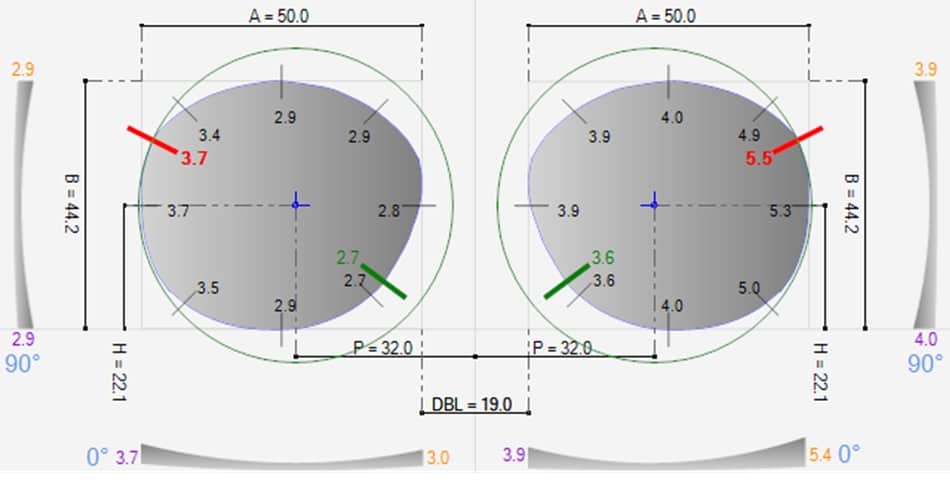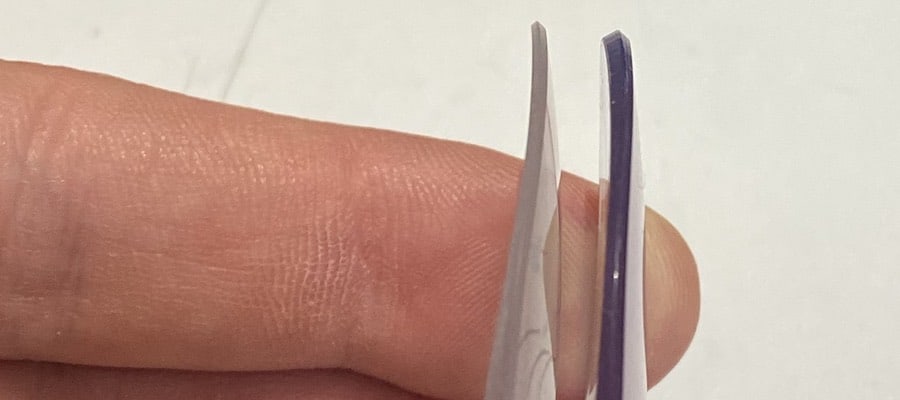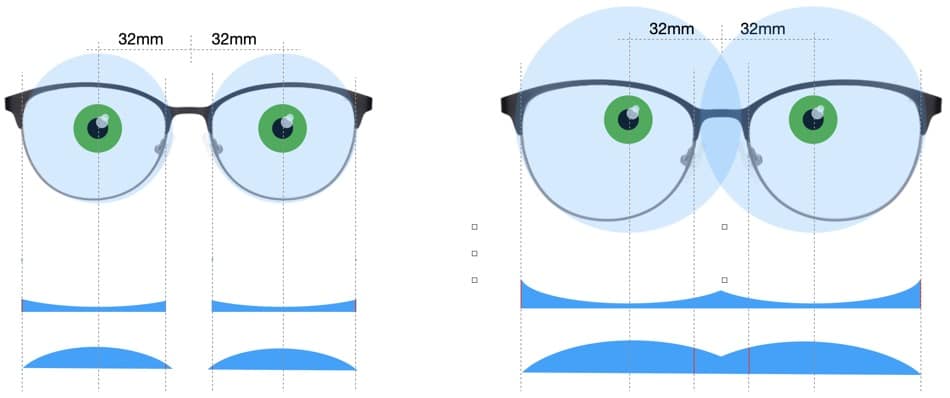Here in this article, we talk about which manufacturer makes the thinnest lenses for glasses. We asked the manufactures listed below to produce the thinnest lenses possible. They had to do the calculations with 4 and 7 Diopters of lens power for Myopes and Hyperopes.
In most cases, Seiko was able to produce the thinnest lenses for glasses possible. However, in some cases, other manufacturers were ahead. I highly recommend you read the whole article to understand what influences the lens thickness and what you should look out for to get the thinnest lenses possible.
For all the calculations I took the same frame with the same measurements. When the manufacturer is done with the calculations I as an optician get something like in the picture below.
Here you can see very easily where the thickest part of the lens will be and how thick it will be. The thickest part of each lens is marked up in red on the picture. This test was done with single vision lenses with the lens materials 1.67 and 1.74.
Please note that the thickness changes with your needed prescription, the frame you choose and how it sits in your face.

Here is the list of the manufactures we asked to do the calculations.
- Zeiss
- Rodenstock
- Seiko
- Essilor
- Hoya
- Shamir
And here are the results for hyperopes with a lens prescription of +4.00D. In most cases the thickest part of the lens edge will be near your nose.
| Hyperopes +4.00D | 1.67 Material | 1.74 Material |
| Zeiss | 3.00 mm | 2.80 mm |
| Rodenstock | 1.97 mm | 1.93 mm |
| Seiko | 1.90 mm | 1.60 mm |
| Essilor | 1.80 mm | 1.80 mm |
| Hoya | 1.73 mm | 2.15 mm |
| Shamir | 2.15 mm | 2.07 mm |
As you can see in the chart above Seiko in this case produced the absolute thinnest lenses the Material with the 1.74 index. However, in most cases, 1.67 will be used because of the optical quality and stability of the lens material. And with the material 1.67 Hoya would [in this case] produce the thinnest lenses.
In some cases the higher index material would theoretically produce the thicker lens. In most cases this will not happen. However if you look at the chart closely. You would see this would happen with Hoya’s lenses in this case. We asked the manufacturer to redo the calculations and the results were the same.
| Myopes -4.0D | 1.67 Material | 1.74 Material |
| Zeiss | 4.30 mm | 3.90 mm |
| Rodenstock | 3.61 mm | 3.17 mm |
| Seiko | 3.20 mm | 2.60 mm |
| Essilor | 3.70 mm | 3.30 mm |
| Hoya | 3.38 mm | 3.14 mm |
| Shamir | 4.50 mm | 3.78 mm |
Here you can see in the table above that Seiko clearly comes out with the thinnest lenses possible. In most cases, with -4.0D the right choice would be to go with the 1.67 index Material. But when the lens power needs to be higher like in our next examples the 1.74 index material becomes more interesting. Despite the optical qualities like the higher probability for color fringes.
| Hyperopes +7.00D | 1.67 Material | 1.74 Material |
| Zeiss | 4.10 mm | 3.80 mm |
| Rodenstock | 2.77 mm | 2.81 mm |
| Seiko | 2.60 mm | 2.40 mm |
| Essilor | 2.40 mm | 2.30 mm |
| Hoya | 2.38 mm | 3.18 mm |
| Shamir | 2.93 mm | 2.77 mm |
The comparison between the thickest and the thinnest lenses was quite big in this case. And yes I double-checked the data we got from the manufactures.
| Myopes -7.00D | 1.67 Material | 1.74 Material |
| Zeiss | 6.80 mm | 6.00 mm |
| Rodenstock | 5.52 mm | 4.78 mm |
| Seiko | 4.80 mm | 4.40 mm |
| Essilor | 5.50 mm | 5.00 mm |
| Hoya | 5.20 mm | 4.79 mm |
| Shamir | 6.80 mm | 5.62 mm |
Again in this case Seiko came out with the thinnest lenses. The data we received is coherent with our experience in our optical shop. Some manufactures just can make the lenses thinner.
In the picture below you can see the difference between a lens which was ordered as thin as possible at Optovision on the left compared to a lens that was ordered as thin as possible at Shamir on the right. (The lens power was the same in the same shape and centration)

If the lens starts out 0.8mm thicker on the edge compared to a thinner one you will end up with an overall thicker lens. In some cases, it makes sense to order a lens with a certain minimum thickness for stability reasons. But if your lens is ordered as thin as possible there are some variations between the lens manufacturers.
One word of caution. Manufacturers have their reasons to shape the lenses as they are. Usually, they achieve a certain effect like optimizing the optical quality in the lens periphery for you. What I want to say is yes there are significant differences between the manufacturers in terms of thickness but your visual experience also plays a role.
Some people do not like the thinnest lenses possible when it comes to the visual experience. Usually, those optimizations are done with a change in the curvature of the lens design like with an aspheric lens. But not every customer likes that. So keep in mind if you do not like the visual experience there are alternatives.
How To Produce the Thinnest Lenses Possible for Your Glasses?
If you want to get your lenses in the thinnest possible way, what you need to do is to order the thinnest lens design, with a higher index material in the most favorable frame. Only when those three points get combined you will get the thinnest lenses possible.
If you ignore one of the points like a favorable shape of the frame thickness and lens weight will be increased. Obviously, this is unnecessary and should be avoided. Especially if your prescription is higher than 3.00D you should be less interested in the really big frames.
Look at this example below. As you can see on the picture are two sizes of the same frame. I marked up the thickest parts of the lenses in red in the cross section below of the frames. If the cross section shows more thickness in the middle those lenses are for hyperopes. If the thinnest part is in the middle of the cross section of those lenses are for myopes.

As you can see if you start out with a frame that is too big from the start or you are looking through the lenses near the rim then you can not expect to end up with the thinnest lenses possible. With such a selected frame you can choose the thinnest lens design with the thinnest material but it will be thick still.
So especially if you have a higher prescription seek advice from your professional. Because s/he will know what will look best and produces the desired result in the end. And keep in mind the choice of the manufacturer can make an impact too to reduce the thickness.
The Pros When Ordering the Lenses in the Thinnest Possible Way
- less weight
- better aesthetics
- less magnifying or minifying effects
The Downside of Ordering Your Lenses in the Thinnest Possible Way
- higher prices
- In some cases, the lower visual quality is experienced
- higher possibility for color fringes
Conclusion
As you can see Seiko took the lead when it comes to producing the thinnest lenses possible. However, keep in mind in this article we did tests with spherical prescriptions. Other prescriptions as with higher astigmatisms can show another picture. The same is true for progressive lenses as those calculations were done for single vision lenses only. But what you can take away from this article is to ask about other manufactures and do the calculations for your case.
Because as you saw it might benefit you in terms of a thinner lens design to switch the manufacturer.
I wish you a great day.
